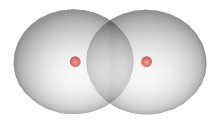
Basic Concepts of Chemical Bonding
Covalent Bonding
Covalent Bonding
Ionic substances:
the electrostatic forces organize the ions of ionic substances into a rigid, organized three-dimensional arrangement
The vast majority of chemical substances are not ionic in nature
G.N. Lewis
reasoned that an atom might attain a noble gas electron configuration by sharing electrons
A chemical bond formed by sharing a pair of electrons is called a covalent bond
The diatomic hydrogen molecule (H2) is the simplest model of a covalent bond, and is represented in Lewis structures as:
The shared pair of electrons provides each hydrogen atom with two electrons in its valence shell (the 1s) orbital.
In a sense, it has the electron configuration of the noble gas helium
When two chlorine atoms covalently bond to form Cl2, the following sharing of electrons occurs:
Each chlorine atom shared the bonding pair of electrons and achieves the electron configuration of the noble gas argon.
In Lewis structures the bonding pair of electrons is usually displayed as a line, and the unshared electrons as dots:
The shared electrons are not located in a fixed position between the nuclei. In the case of the H2 compound, the electron density is concentrated between the two nuclei:

The two atoms are bound into the H2 molecule mainly due to the attraction of the positively charged nuclei for the negatively charged electron cloud located between them
For the nonmetals (and the 's' block metals) the number of valence electrons is equal to the group number:
|
Element |
Group |
Valence electrons |
Bonds needed to form valence octet |
|
F |
7A |
7 |
1 |
|
O |
6A |
6 |
2 |
|
N |
5A |
5 |
3 |
|
C |
4A |
4 |
4 |
Examples of hydride compounds of the above elements (covalent bonds with hydrogen:
Thus, the Lewis bonds successfully describe the covalent interactions between various nonmetal elements
Multiple bonds
The sharing of a pair of electrons represents a single covalent bond, usually just referred to as a single bond
In many molecules atoms attain complete octets by sharing more than one pair of electrons between them.
Two electron pairs shared a double bond
Three electron pairs shared a triple bond
Because each nitrogen contains 5 valence electrons, they need to share 3 pairs to each achieve a valence octet.
From a study of various Nitrogen containing compounds bond distance as a function of bond type can be summarized as follows:
As a general rule, the distance between bonded atoms decreases as the number of shared electron pairs increases
1996 Michael Blaber